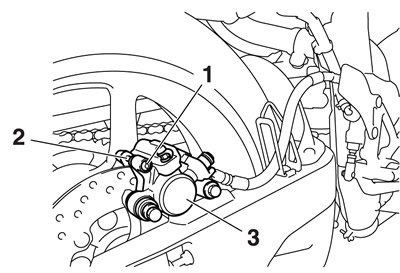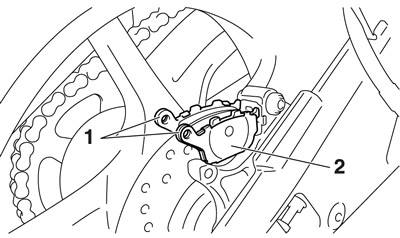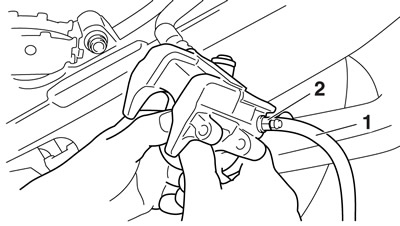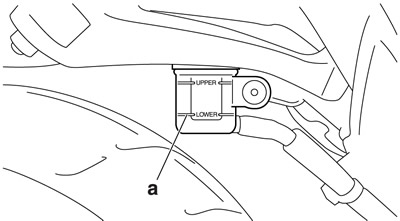1. Remove:
- Screw plug "1"
- Brake pad pin "2"
- Brake caliper "3"
- Brake pad spring

2. Remove:
- Brake pads "1" (along with the brake pad shims "2")

Measure:
- Brake pad wear limit "a"
Out of specification → Replace the brake pads as a set.
Bake Brake pad lining thickness (inner) 6.0 mm (0.24 in).
Limit 1.0 mm (0.04 in).
Brake pad lining thickness (outer) 6.0 mm (0.24 in).
Limit 1.0 mm (0.04 in).

4. Install:
- Brake pad shims (onto the brake pads)
- Brake pads
- Brake pad spring
Always install new brake pads, brake pad shims, and a brake pad spring as a set.
a. Connect a clear plastic hose "1" tightly to the bleed screw "2". Put the other end of the hose into an open container.

b. Loosen the bleed screw and push the brake caliper pistons into the brake caliper with your finger.
c. Tighten the bleed screw.
Bleed screw 5 Nm (0.5 m·kgf, 3.6 ft·lbf).
d. Install a new brake pad shim "3" onto each new brake pad "4".

5. Install:
- Brake pad pin
- Screw plug
- Brake caliper
Rear brake caliper bolt (front side) 27 Nm (2.7 m·kgf, 19 ft·lbf).
Rear brake caliper bolt (rear side) 22 Nm (2.2 m·kgf, 16 ft·lbf).
6. Check:
- Brake fluid level
Below the minimum level mark "a" → Add the recommended brake fluid to the proper level.
Refer to "Checking the brake fluid level".

7. Check:
- Brake pedal operation
Soft or spongy feeling → Bleed the brake system.
Refer to "Bleeding the hydraulic brake system".
